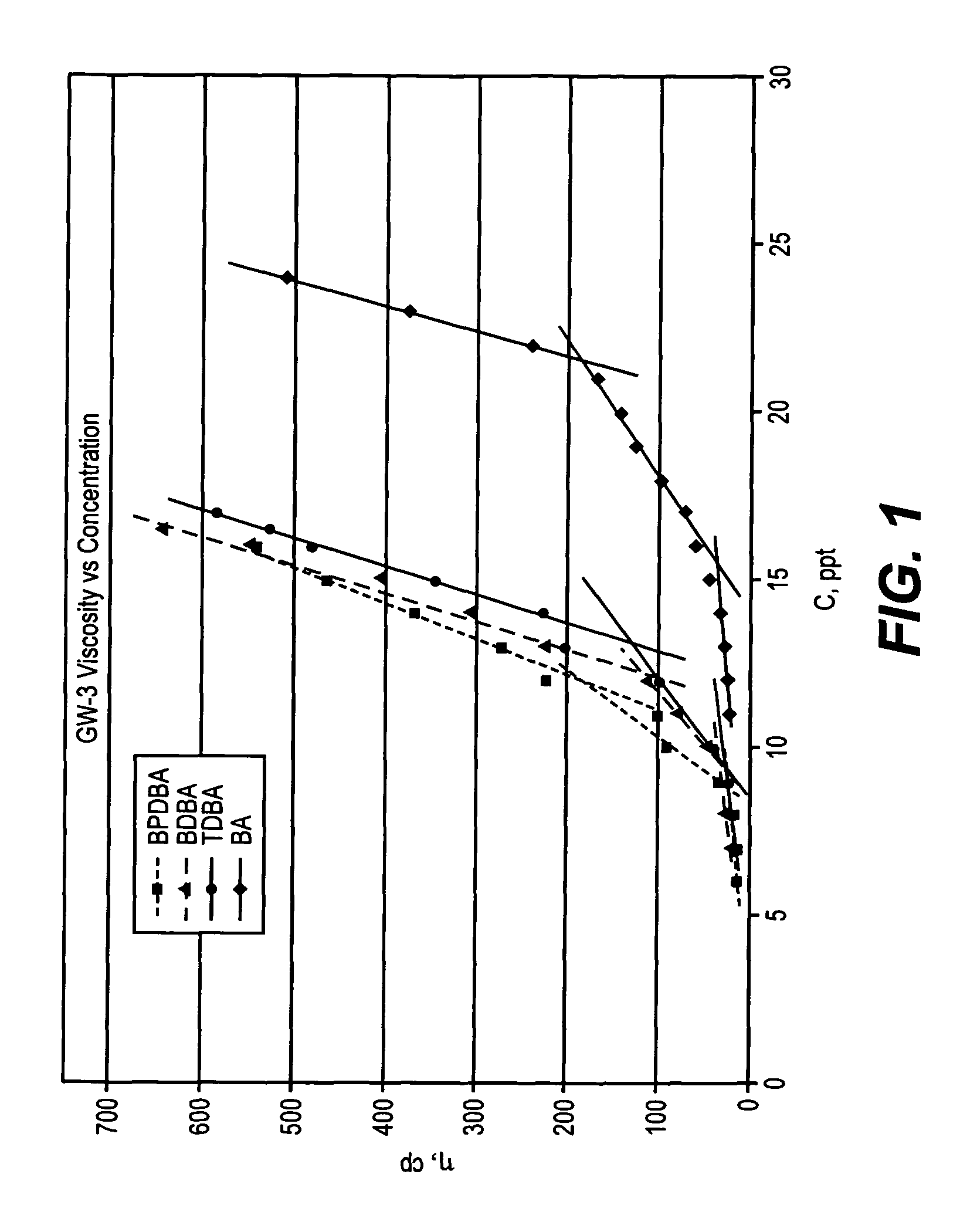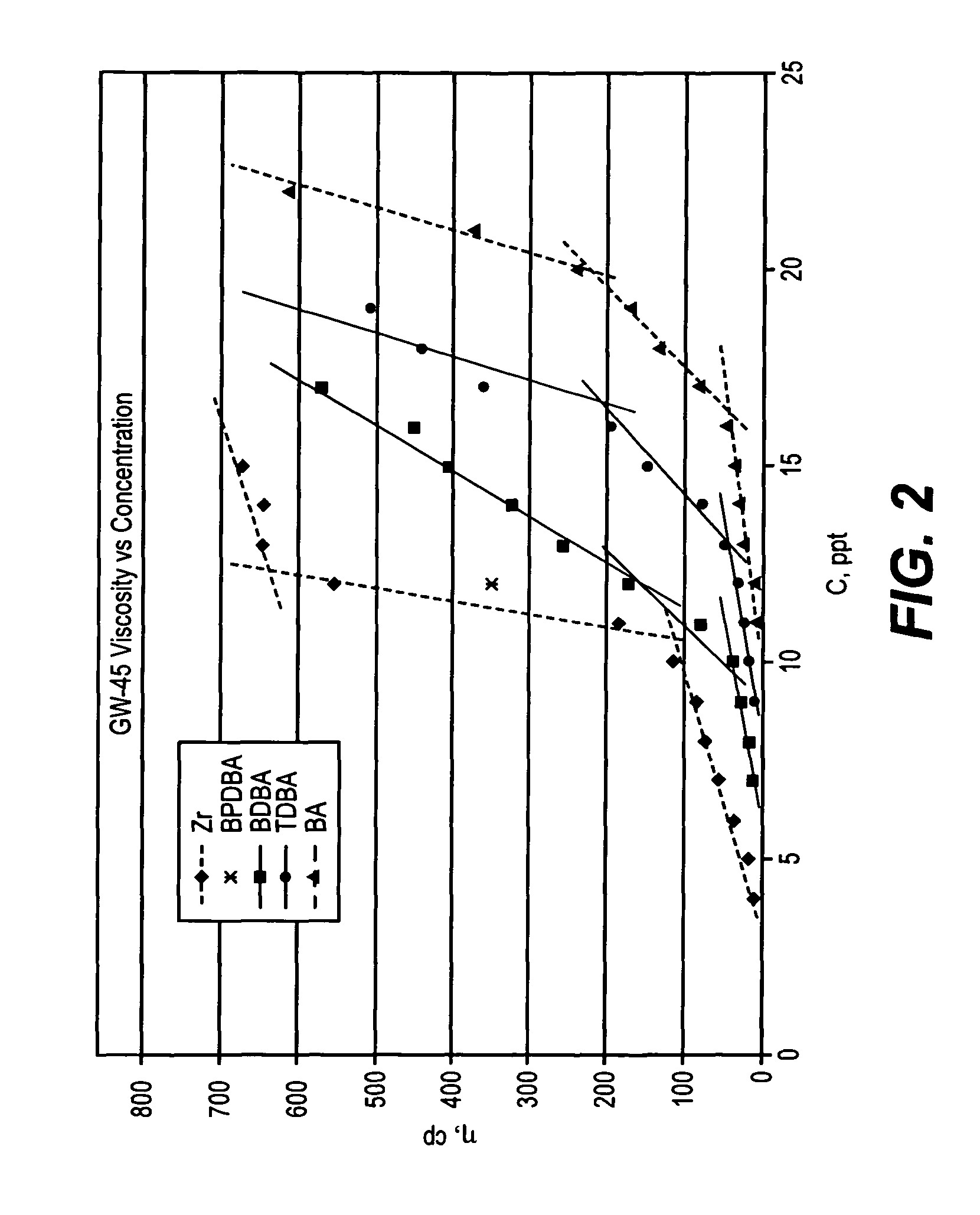Fracturing method using polyboronic compound
a polyboronic compound and fracturing method technology, applied in the field of polyboronic compounds, can solve the problems of huge horsepower and the desire for delayed crosslinkers, and achieve the effect of reducing overall treatment costs, reducing polymer loading, and equivalent fracturing fluid performan
- Summary
- Abstract
- Description
- Claims
- Application Information
AI Technical Summary
Benefits of technology
Problems solved by technology
Method used
Image
Examples
example 1
[0088]Example 1 was used to determine Ccc and to test the effectiveness of the crosslinking agents made in accordance with embodiments of the present invention. 25 ppt (0.3%) solution of guar gum (GW-3, which is commercially available from Baker Hughes Incorporated) was prepared by hydrating GW-3 powder. After at least 30 minutes, the solution was systematically diluted to obtain 6, 7, 8, 9, 10, 11, 12, 13, 14, 15, 16, 17, 18, 19, 20, 21, 22, 23, 24 ppt solutions. Other additives (such as buffer, clay stabilizer, and bactericide) were added to the GW-3 guar solution. The crosslinking agents made in accordance with embodiments of the present invention were then added by mixing. The polymer / crosslinking agent ratio was kept constant. The viscosity of the crosslinked gel was measured on Fann 35 instrument at room temperature. The polymer / crosslinking agent ratios were as follows:
[0089]
TDBA / GW-3 = 0.079BDBA / GW-3 = 0.039BPDBA / GW-3 = 0.056BA / GW-3 = 0.022TDBA / GW-45 = 1.10BDBA / GW-45 = 1.13B...
example 2
[0090]The Ccc values were calculated for two different types of guar fracturing fluids, GW-3 and GW-45, that were crosslinked with four different types of crosslinking agents. GW-3 and GW-45 are guar based polymers commercially available from Baker Hughes Incorporated. As can be seen in Table 1, a lower Ccc was obtained using the various polyboronic compounds (i.e., TDBA, BDBA, and BPDBA) when compared to the same guar polymers being crosslinked with conventional boric acid (BA). The results of this example show that the type of crosslinking agent can greatly affect the Ccc, which is contrary to what is conventionally accepted in the industry.
[0091]
TABLE 1Ccc, pptPolymerBATDBABDBABPDBAGW-31598.58GW-4515.5128.5
example 3
[0092]In this example, the viscoelastic properties (n′) and viscosities (cP) of two crosslinked guar polymer systems were compared. 15 ppt of GW-3 was crosslinked with 0.27 mmol BPDBA at 150° F. and compared with a typical crosslinked system that was prepared by crosslinking 20 ppt of GW-3 with CXB-10, which is commercially available from Baker Hughes Incorporated. As shown in Table 2, the results clearly demonstrate that these polyboronic compounds used in embodiments of the present invention can effectively lower polymer loading for fracturing stimulation. The reduction of the polymer loading is related to the size of the group separating the two boronic acids.
[0093]
TABLE 215 ppt GW-3, 0.27 mmol BPDBA20 ppt GW-3, 1 gpt CXB-10Viscosity (cP) atViscosity (cP) atTime,4010017040100511minn′sec−1sec−1sec−1n′sec−1sec−1sec−12.10.6714813562990.3891855106039132.103485823202270.53334922810662.10.3586653692630.87134330524792.10.2766943582440.753317253169122.10.4434892932180.814314265195
PUM
| Property | Measurement | Unit |
|---|---|---|
| concentrations | aaaaa | aaaaa |
| concentrations | aaaaa | aaaaa |
| temperature | aaaaa | aaaaa |
Abstract
Description
Claims
Application Information
 Login to View More
Login to View More - R&D
- Intellectual Property
- Life Sciences
- Materials
- Tech Scout
- Unparalleled Data Quality
- Higher Quality Content
- 60% Fewer Hallucinations
Browse by: Latest US Patents, China's latest patents, Technical Efficacy Thesaurus, Application Domain, Technology Topic, Popular Technical Reports.
© 2025 PatSnap. All rights reserved.Legal|Privacy policy|Modern Slavery Act Transparency Statement|Sitemap|About US| Contact US: help@patsnap.com



